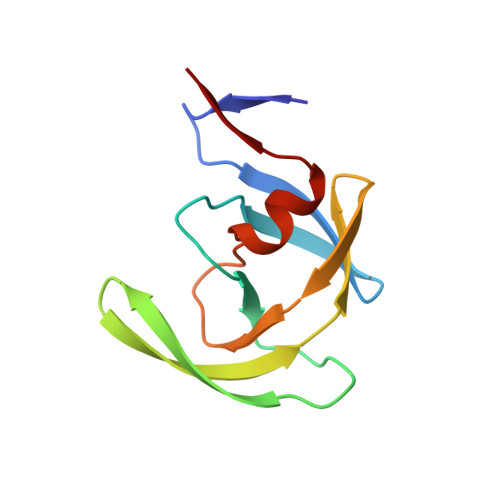Human immunodeficiency virus protease ligand specificity conferred by residues outside of the active site cavity.
Hoog, S.S., Towler, E.M., Zhao, B., Doyle, M.L., Debouck, C., Abdel-Meguid, S.S.(1996) Biochemistry 35: 10279-10286
- PubMed: 8756683
- DOI: https://doi.org/10.1021/bi960179j
- Primary Citation of Related Structures:
1TCW, 1TCX - PubMed Abstract:
To gain greater understanding of the structural basis of human immunodeficiency virus (HIV) protease ligand specificity, we have crystallized and determined the structures of the HIV-1 protease (Val32Ile, Ile47Val, Val82Ile) triple mutant and simian immunodeficiency virus (SIV) protease in complex with SB203386, a tripeptide analogue inhibitor containing a C-terminal imidazole substituent as an amide bond isostere. SB203386 is a potent inhibitor of HIV-1 protease (Ki = 18 nM) but shows decreased inhibition of the HIV-1 protease (Val32Ile, Ile47Val, Val82Ile) triple mutant (Ki = 112 nM) and SIV protease (Ki = 960 nM). Although SB203386 binds in the active site cavity of the triple mutant in a similar fashion to its binding to the wild-type HIV-1 protease [Abdel-Meguid et al. (1994) Biochemistry 33, 11671], it binds to SIV protease in an unexpected mode showing two inhibitor molecules each binding to half of the active site. Comparison of these two structures and that of the wild-type HIV-1 protease bound to SB203386 reveals that HIV protease ligand specificity is imparted by residues outside of the catalytic pocket, which causes subtle changes in its shape. Furthermore, this work illustrates the importance of structural studies in order to understand the structure-activity relationship (SAR) between related enzymes.
Organizational Affiliation:
Department of Macromolecular Sciences, SmithKline Beecham Pharmaceuticals, King of Prussia, Pennsylvania 19406, USA.















